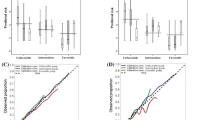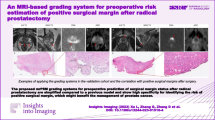Abstract
Objectives
To propose a novel scoring system to predict the risk of positive surgical margin (PSM) after radical prostatectomy (RP) in prostate cancer (PCa) patients.
Materials and methods
Eight reproducible variables available from preoperative characteristics of PCa patients were measured: PSA level (P), ratio of positive biopsy needles (R), obesity (O), scores of Gleason (S), T stage by preoperative MRI scan (T), age (A), tumor volume (T) and experience of the surgeon (E). Of the eight components, seven were scored on a 0-, 1- or 2-point scale, with only the “A” component on a 0- or 1-point scale. The P.R.O.S.T.A.T.E. scores can range from 0 to 15.
Results
A total of 441 patients were included from the Peking University First Hospital between November 2007 and March 2016, among whom 195 patients (44.2%) had a PSM identified by a postoperative pathological examination. The preoperative P.R.O.S.T.A.T.E. scores statistically correlated with the postoperative SM status (p < 0.001) when the 441 consecutive patients were divided into three groups (low-risk group: score of 0–4, moderate-risk group: score of 5–9 and high-risk group: score of 10–15). The risk of PSM after RP in the low-risk, moderate-risk and high-risk groups was 21.1, 40.1 and 87.0%, respectively.
Conclusions
The novel scoring system of P.R.O.S.T.A.T.E. that we presented was found to predict the risk of PSM after RP. A combination of reproducible, standardized parameters obtained from preoperative characteristics of PCa patients can be used as a tool for predicting PSM, thus assisting in the strategy of performing surgical procedures. More careful manipulation or wider resection may be of utmost importance in the high-risk group.


Similar content being viewed by others
References
Arees D, Mieke VH, Wahyu W et al (2016) Are you now a good surgeon? T2 positive margin status as a quality outcome measure following radical prostatectomy. World J Urol 1:1–9
Boehm K, Graefen M (2015) Nerve-sparing surgery and risk of positive surgical margins. Nat Rev Urol 12:131–132
Caroline P, Yann N, Camelia R et al (2015) Positive surgical margins after radical prostatectomy: What should we care about? World J Urol 33:1973–1978
Christian VB, Marko B, Florian R et al (2013) Intraoperative frozen section of the prostate decreases positive margin rate while ensuring nerve sparing procedure during radical prostatectomy. J Urol 190:515–520
D’Amico AV, Whittington R, Malkowicz SB et al (1998) Biochemical outcome after radical prostatectomy, external beam radiation therapy, or interstitial radiation therapy for clinically localized prostate cancer. JAMA 280:969–974
Fleshner NE, Evans A, Chadwick K et al (2010) A clinical significance of the positive surgical margin based upon location, grade, and stage. Urol Oncol 28:197–204
Fontenot PA, Mansour AM (2013) Reporting positive surgical margins after radical prostatectomy: time for standardization. BJU Int 111:e290–e299
Howard J, Eunis N, Jeffrey MS et al (2012) Impact of median lobe anatomy: Does its presence affect surgical margin rates during robot-assisted laparoscopic prostatectomy? J Endourol 26:457–460
Kutikov A, Uzzo RG (2009) The R.E.N.A.L. nephrometry score: a comprehensive standardized system for quantitating renal tumor size, location and depth. J Urol 182:844–853
Liss M, Osann K, Ornstein D (2008) Positive surgical margins during robotic radical prostatectomy: a contemporary analysis of risk factors. BJU Int 102:603–607
Luke TL, Andrew S, Sonva C et al (2016) The effect of wide resection during radical prostatectomy on surgical margins. Can Urol Assoc J 10:14–17
Nazareno S, Paolo D, Andrea G et al (2016) Evaluation of positive surgical margins in patients undergoing robot-assisted and open radical prostatectomy according to preoperative risk groups. Urol Oncol 34:57e1–57e7
Orr DP, Fineberg NS, Gray DL (1996) Glycemic control and transfer of health care among adolescents with insulin dependent diabetes mellitus. J Adolesc Health 18:44–47
Partin AW, Yoo J, Carter HB et al (1993) The use of prostate specific antigen, clinical stage and Gleason score to predict pathological stage in men with localized prostate cancer. J Urol 150:110–114
Preston MA, Breau RH, Lantz AG et al (2015) The association between nerve sparing and a positive surgical margin during radical prostatectomy. Urol Oncol 33:18e1–18e6
Rafael FC, Sanket C, Marcelo AO et al (2010) Predictive factors for positive surgical margins and their locations after robot-assisted laparoscopic radical prostatectomy. Eur Urol 57:1022–1029
Ren S, Wang F, Shen J et al (2013) Long non-coding RNA metastasis associated in lung adenocarcinoma transcript 1 derived miniRNA as a novel plasma-based biomarker for diagnosing prostate cancer. Eur J Cancer 49:2949–2959
Sultan SA, Shabbir MA, Antonio F et al (2010) Does nerve-sparing radical prostatectomy increase the risk of positive surgical margins and biochemical progression? Urol Ann 2:58–62
Tward JD, Lee CM, Pappas LM et al (2006) Survival of men with clinically localized prostate cancer treated with prostatectomy, brachytherapy, or no definitive treatment. Cancer 107:2392–2400
Vincenzo F, Giacomo N, Silvia S et al (2009) Predictors of positive surgical margins after laparoscopic robot assisted radical prostatectomy. J Urol 182:2682–2688
Vipul RP, Rafael FC, Bernardo R et al (2011) Positive surgical margins after robotic assisted radical prostatectomy: a multi-institutional study. J Urol 186:511–517
Williams SB, Chen MH, D’Amico AV et al (2010) Radical retropubic prostatectomy and robotic-assisted laparoscopic prostatectomy: likelihood of positive surgical margin(s). Urology 76:1097–1101
Zhamshid O, Justin IF, Arvin KG et al (2013) S.T.O.N.E. nephrolithometry: novel surgical classification system for kidney calculi. Urology 81:1154–1160
Zorn KC, Gofrit ON, Steinberg GP et al (2008) Planned nerve preservation to reduce positive surgical margins during robot-assisted laparoscopic radical prostatectomy. J Endourol 22:1303–1309
Author’s contribution
XB was involved in project development and manuscript writing; LC performed data collection and data analysis; ZQ performed data collection; and JJ reviewed the key points of this manuscript.
Author information
Authors and Affiliations
Corresponding authors
Ethics declarations
Conflict of interest
There is no conflict of interest involved in this manuscript.
Ethical standards
All authors have made a significant contribution to the findings and methods in the paper. All authors have read and approved the final draft. There are no financial interests. The work has not already been published and has not been submitted simultaneously to any other journal. The corresponding author takes on these responsibilities with his signature.
Additional information
Ben Xu and Cheng Luo have contributed equally to this work.
Rights and permissions
About this article
Cite this article
Xu, B., Luo, C., Zhang, Q. et al. Preoperative characteristics of the P.R.O.S.T.A.T.E. scores: a novel predictive tool for the risk of positive surgical margin after radical prostatectomy. J Cancer Res Clin Oncol 143, 687–692 (2017). https://doi.org/10.1007/s00432-016-2313-2
Received:
Accepted:
Published:
Issue Date:
DOI: https://doi.org/10.1007/s00432-016-2313-2




